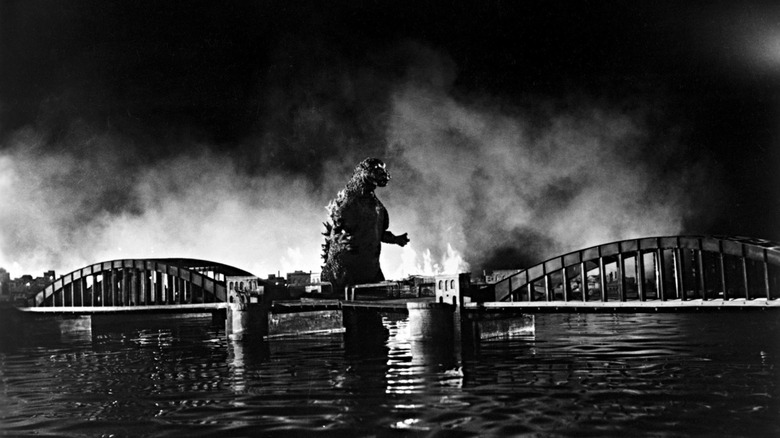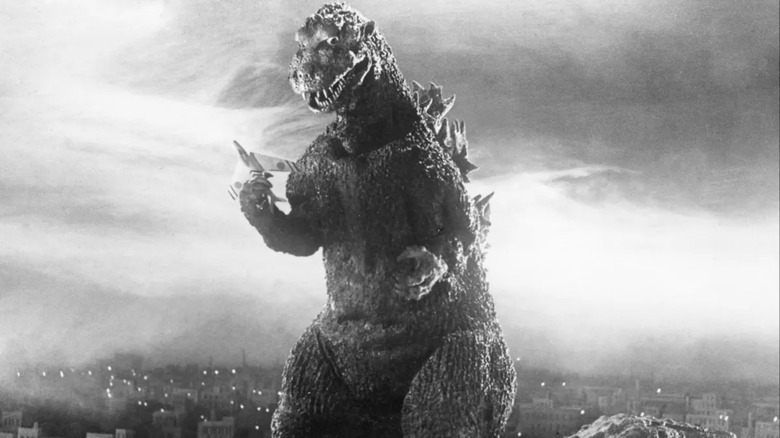The First Attempt At Filming Godzilla's Tokyo Rampage Was A Total Disaster
After a 160-ft tall prehistoric monster rises out of the sea and crushes an entire village in 1954's "Godzilla," all hell breaks loose. Professionals scramble to study this ginormous beast in hopes of understanding its motives but soon realize that its mutated form follows no logic while leaving destruction in its wake. Even after a 100-ft electrified fence is built to keep the monster out, it demolishes this obstacle with its atomic breath along with the city of Tokyo, leaving thousands dead and injured before temporarily returning to the sea.
The only way director Ishirō Honda and special effects creator Eiji Tsuburaya could portray Godzilla's unforgettable Tokyo rampage was through practical means, and it was certainly not easy to pull off. At the time, Godzilla was portrayed by a man in a rubber suit — namely Nakajima Haruo, who brought the iconic monster's telltale mannerisms to life — which meant that he had to act out the choreographed destruction without missing a beat. With Tsuburaya popularizing the "tokusatsu" form of filming (which had origins in Japanese kabuki theater), a painstakingly detailed miniature set of Tokyo was juxtaposed against the man in a suit, allowing for the destruction to unfold in a manner that would appear seamless in the final cut.
However, according to the 15th issue of volume 19 of "LIFE" magazine, simply titled "Godzilla," Haruo was not the only one who donned the suit when this scene was shot, which led to several complications that had to be ironed out while contending with limited resources and other filmmaking concerns. Here is what happened.
Mimicking Godzilla's rampage of a miniature Tokyo
Japanese actor Katsumi Tezuka, best known for playing several monsters in most Toho-helmed films (including Anguirus in "Godzilla Raids Again"), was brought in first to enact the rampage after Tsuburaya built a 1:25 scale model of Tokyo. Although miniature cities or backdrops were not rare at the time, the portrayal of city-wide destruction (by a kaiju) had never been attempted before. As a result, Tsuburaya's instructions for Tezuka were rather blunt, per the "LIFE" issue:
"All right, all you have to do is just walk in a straight line. Remember that we built a channel behind the platform in the middle, so just walk from the back of the platform right straight through the building. Don't stop unless I tell you to. Any questions? No. Good. All right, places everybody!"
As a slow-motion effect had to be created, the camera ran faster than usual while Tezuka carried out the enaction. Although he did a good job, he unfortunately tripped and fell, causing some of the miniature structures to break. Creating them the first time was pretty time-consuming, but Tsuburaya and his crew had no option but to mend the broken parts and reshoot the scene with Nakajima. However, the suit donned by both actors was clunky, uncomfortable, and seemed artificial (having been cobbled together with bamboo, wires, and latex among other things), which meant most of the movie magic unfolded during the editing stage.
To preserve time and everyone's sanity, the amateur aspects of the scene were smartly tweaked by Tsuburaya, where he intercut "the suitmation footage with puppet versions of the monster" to inject depth and realism into a scene of massive gravity. The efforts paid off, setting a precedent for monsters rampaging cities on the big screen.

